Comparing Large-Eddy Simulation and Gaussian Plume Model to Sensor Measurements of an Urban Smoke Plume
Abstract
1. Introduction
1.1. Short-Term Release and Exposure
1.2. Fast Prediction of Dispersion from a Short-Term Release
1.3. Outline of the Current Work
2. The Case Study
2.1. The Accidental Fire
2.2. The Meteorological Conditions
3. Methodology and Settings
3.1. Sensor Network
3.2. The Gaussian Plume Model in ADMS and Settings
3.3. Large-Eddy Simulation in OpenFOAM and Its Settings
4. Measured PM2.5 Concentration from the Sensor Network
4.1. Verification of the Sensor Measurement during the Fire Incident
4.2. Estimation of the Fire Start Time from the Sensor Data
4.3. Discussion of the Fire Duration Based on the Sensor Data
5. Numerical Simulations and Estimation of the Emission Rate
5.1. Estimated Concentration from ADMS
5.2. Estimation of the Fire Start Time from OpenFOAM
5.3. Estimation of the Emission Rate from Available Data
5.4. Uncertainties and Confidence of the Estimation
6. Discussion and Concluding Remarks
6.1. Advantages and Limitations of Both Numerical Approaches, and Their Potential Roles in Fast Response Applications
6.2. Concluding Remarks
Author Contributions
Funding
Institutional Review Board Statement
Informed Consent Statement
Data Availability Statement
Acknowledgments
Conflicts of Interest
References
- Fackrell, J.; Robins, A. Concentration fluctuations and fluxes in plumes from point sources in a turbulent boundary layer. J. Fluid Mech. 1982, 117, 1–26. [Google Scholar] [CrossRef]
- Carruthers, D.; Mckeown, A.; Hall, D.; Porter, S. Validation of ADMS against wind tunnel data of dispersion from chemical warehouse fires. Atmos. Environ. 1999, 33, 1937–1953. [Google Scholar] [CrossRef]
- Ambade, B. Characterization of PM 10 over urban and rural sites of Rajnandgaon, central India. Nat. Hazards 2016, 80, 589–604. [Google Scholar] [CrossRef]
- Xie, Z.T. modeling Street-Scale Flow and Dispersion in Realistic Winds—Towards Coupling with Mesoscale Meteorological Models. Bound.-Layer Meteorol. 2011, 141, 53–75. [Google Scholar] [CrossRef]
- Luo, X.; Bing, H.; Luo, Z.; Wang, Y.; Jin, L. Impacts of atmospheric particulate matter pollution on environmental biogeochemistry of trace metals in soil-plant system: A review. Environ. Pollut. 2019, 255, 113138. [Google Scholar] [CrossRef]
- Yim, S.; Li, Y.; Huang, T.; Lim, J.; Lee, H.; Chotirmall, S.; Dong, G.; Abisheganaden, J.; Wedzicha, J.; Schuster, S.; et al. Global health impacts of ambient fine particulate pollution associated with climate variability. Environ. Int. 2024, 186, 108587. [Google Scholar] [CrossRef] [PubMed]
- Hussain, A.J.; Sankar, T.K.; Vithanage, M.; Ambade, B.; Gautam, S. Black carbon emissions from traffic contribute sustainability to air pollution in urban cities of India. Water Air Soil Pollut. 2023, 234, 217. [Google Scholar] [CrossRef]
- Mole, N.; Anderson, C.; Nadarajah, S.; Wright, C. A generalized pareto distribution model for high concentrations in short-range atmospheric dispersion. Environmetrics 1995, 6, 595–606. [Google Scholar] [CrossRef]
- Xie, Z.T.; Hayden, P.; Robins, A.G.; Voke, P.R. modeling extreme concentrations from a source in a turbulent flow over a rough wall. Atmos. Environ. 2007, 41, 3395–3406. [Google Scholar] [CrossRef]
- Nelson, M.; Addepalli, B.; Hornsby, F.; Gowardhan, A.; Pardyjak, E.; Brown, M. 5.2 Improvements to a Fast-Response Urban Wind Model. In Proceedings of the American Meteorological Society 88th Annual Meeting, New Orleans, LA, USA, 22 January 2008; pp. 20–24. [Google Scholar]
- Hertwig, D.; Soulhac, L.; Fuka, V.; Auerswald, T.; Carpentieri, M.; Hayden, P.; Robins, A.; Xie, Z.T.; Coceal, O. Evaluation of fast atmospheric dispersion models in a regular street network. Environ. Fluid Mech. 2018, 18, 1007–1044. [Google Scholar] [CrossRef]
- Santos, J.M.; Reis, N.; Castro, I.; Goulart, E.V.; Xie, Z.T. Using large-eddy simulation and wind-tunnel data to investigate peak-to-mean concentration ratios in an urban environment. Bound.-Layer Meteorol. 2019, 172, 333–350. [Google Scholar] [CrossRef]
- Hankey, S.; Marshall, J.D. Urban Form, Air Pollution, and Health. Curr. Environ. Health Rep. 2017, 4, 491–503. [Google Scholar] [CrossRef]
- Künzli, N.; Tager, I.B. Air pollution: From lung to heart. Swiss Med. Wkly. 2005, 135, 697–702. [Google Scholar] [PubMed]
- Oudin, A.; Forsberg, B.; Jakobsson, K. Air pollution and stroke. Epidemiology 2012, 23, 505–506. [Google Scholar] [CrossRef] [PubMed]
- Maximillian, J.; Brusseau, M.; Glenn, E.; Matthias, A. Pollution and Environmental Perturbations in the Global System, 3rd ed.; Elsevier Inc.: Amsterdam, The Netherlands, 2019; pp. 457–476. [Google Scholar]
- Cohen, A.J.; Brauer, M.; Burnett, R.; Anderson, H.R.; Frostad, J.; Estep, K.; Balakrishnan, K.; Brunekreef, B.; Dandona, L.; Dandona, R.; et al. Estimates and 25-year trends of the global burden of disease attributable to ambient air pollution: An analysis of data from the Global Burden of Diseases Study 2015. Lancet 2017, 389, 1907–1918. [Google Scholar] [CrossRef]
- Becnel, T.; Tingey, K.; Whitaker, J.; Sayahi, T.; Le, K.; Goffin, P.; Butterfield, A.; Kelly, K.; Gaillardon, P.E. A Distributed Low-Cost Pollution Monitoring Platform. IEEE Internet Things J. 2019, 6, 10738–10748. [Google Scholar] [CrossRef]
- Bi, J.; Carmona, N.; Blanco, M.N.; Gassett, A.J.; Seto, E.; Szpiro, A.A.; Larson, T.V.; Sampson, P.D.; Kaufman, J.D.; Sheppard, L. Publicly available low-cost sensor measurements for PM2.5 exposure modeling: Guidance for monitor deployment and data selection. Environ. Int. 2022, 158, 106897. [Google Scholar] [CrossRef]
- Bulot, F.M.J.; Russell, H.S.; Rezaei, M.; Johnson, M.S.; Ossont, S.J.J.; Morris, A.K.R.; Basford, P.J.; Easton, N.H.C.; Foster, G.L.; Loxham, M.; et al. Laboratory comparison of low-cost particulate matter sensors to measure transient events of pollution. Sensors 2020, 20, 2219. [Google Scholar] [CrossRef]
- Johnston, S.J.; Basford, P.J.; Bulot, F.M.; Apetroaie-Cristea, M.; Easton, N.H.; Davenport, C.; Foster, G.L.; Loxham, M.; Morris, A.K.; Cox, S.J. City scale particulate matter monitoring using LoRaWAN based air quality IoT devices. Sensors 2019, 19, 209. [Google Scholar] [CrossRef]
- Kadri, A.; Yaacoub, E.; Mushtaha, M.; Abu-Dayya, A. Wireless sensor network for real-time air pollution monitoring. In Proceedings of the 2013 1st International Conference on Communications, Signal Processing and Their Applications, ICCSPA 2013, Sharjah, United Arab Emirates, 12–14 February 2013. [Google Scholar]
- Tsujita, W.; Yoshino, A.; Ishida, H.; Moriizumi, T. Gas sensor network for air-pollution monitoring. Sens. Actuators B Chem. 2005, 110, 304–311. [Google Scholar] [CrossRef]
- Hall, D.; Kukadia, V.; Walker, S. Plume Dispersion from Chemical Warehouse Fires; Building Research Establishment Report; Building Research Establishment: Garston, UK, 1995; Volume CR 56/95. [Google Scholar]
- Vedal, S.; Dutton, S.J. Wildfire air pollution and daily mortality in a large urban area. Environ. Res. 2006, 102, 29–35. [Google Scholar] [CrossRef] [PubMed]
- Cusworth, D.H.; Mickley, L.J.; Sulprizio, M.P.; Liu, T.; Marlier, M.E.; Defries, R.S.; Guttikunda, S.K.; Gupta, P. Quantifying the influence of agricultural fires in northwest India on urban air pollution in Delhi, India. Environ. Res. Lett. 2018, 13, 044018. [Google Scholar] [CrossRef]
- Emmanuel, S. Impact to Lung Health of Haze from Forest Fires: The Singapore Experience. Respirology 2000, 5, 175–182. [Google Scholar] [CrossRef] [PubMed]
- Cambridge Environmental Research Consultants. ADMS 6 Buildings Validation—Warehouse Fires Wind Tunnel Experiments. Technical Report, Cambridge Environmental Research Consultants. 2023. Available online: https://www.cerc.co.uk/environmental-software/assets/data/doc_validation/CERC_ADMS6_Study_Validation_WarehouseFires_5_2_vs_6_0.pdf (accessed on 2 September 2024).
- Boris, J. The threat of chemical and biological terrorism: Preparing a response. Comput. Sci. Eng. 2002, 4, 22–32. [Google Scholar] [CrossRef]
- Soulhac, L.; Salizzoni, P.; Cierco, F.X.; Perkins, R. The model SIRANE for atmospheric urban pollutant dispersion; part I, presentation of the model. Atmos. Environ. 2011, 45, 7379–7395. [Google Scholar] [CrossRef]
- Coburn, M.; Xie, Z.T. Increasing high-fidelity modeling efficiency with automation and machine learning. In Proceedings of the Engineering Mechanics Institute Conference and Probabilistic Mechanics & Reliability Conferenc, Chicago, IL, USA, 28–31 May 2024. [Google Scholar]
- Zheng, X.; Montazeri, H.; Blocken, B. Large-eddy simulation of pollutant dispersion in generic urban street canyons: Guidelines for domain size. J. Wind Eng. Ind. Aerodyn. 2021, 211, 104527. [Google Scholar] [CrossRef]
- Tominaga, Y.; Stathopoulos, T. CFD modeling of pollution dispersion in a street canyon: Comparison between LES and RANS. J. Wind Eng. Ind. Aerodyn. 2011, 99, 340–348. [Google Scholar] [CrossRef]
- Sessa, V.; Xie, Z.T.; Herring, S. Thermal stratification effects on turbulence and dispersion in internal and external boundary layers. Bound.-Layer Meteorol. 2020, 176, 61–83. [Google Scholar] [CrossRef]
- Tominaga, Y.; Stathopoulos, T. CFD simulation of near-field pollutant dispersion in the urban environment: A review of current modeling techniques. Atmos. Environ. 2013, 79, 716–730. [Google Scholar] [CrossRef]
- Weller, H.G.; Tabor, G.; Jasak, H.; Fureby, C. A tensorial approach to computational continuum mechanics using object-oriented techniques. Comput. Phys. 1998, 12, 620–631. [Google Scholar] [CrossRef]
- Kadaverugu, R.; Sharma, A.; Matli, C.; Biniwale, R. High resolution urban air quality modeling by coupling CFD and mesoscale models: A review. Asia-Pac. J. Atmos. Sci. 2019, 55, 539–556. [Google Scholar] [CrossRef]
- Bhaganagar, K.; Bhimireddy, S.R. Numerical investigation of starting turbulent buoyant plumes released in neutral atmosphere. J. Fluid Mech. 2020, 900, A32. [Google Scholar] [CrossRef]
- Zhong, J.; Cai, X.; Xie, Z.T. Implementation of a synthetic inflow turbulence generator in idealised WRF v3. 6.1 large eddy simulations under neutral atmospheric conditions. Geosci. Model Dev. 2021, 14, 323–336. [Google Scholar] [CrossRef]
- Kumar, M.; Jonko, A.; Lassman, W.; Mirocha, J.D.; Kosović, B.; Banerjee, T. Impact of momentum perturbation on convective boundary layer turbulence. J. Adv. Model. Earth Syst. 2024, 16, e2023MS003643. [Google Scholar] [CrossRef]
- Maronga, B.; Gryschka, M.; Heinze, R.; Hoffmann, F.; Kanani-Sühring, F.; Keck, M.; Ketelsen, K.; Letzel, M.O.; Sühring, M.; Raasch, S. The Parallelized Large-Eddy Simulation Model (PALM) version 4.0 for atmospheric and oceanic flows: Model formulation, recent developments, and future perspectives. Geosci. Model Dev. 2015, 8, 2515–2551. [Google Scholar] [CrossRef]
- Cimorelli, A.J.; Perry, S.G.; Venkatram, A.; Weil, J.C.; Paine, R.J.; Wilson, R.B.; Lee, R.F.; Peters, W.D.; Brode, R.W. AERMOD: A dispersion model for industrial source applications. Part I: General model formulation and boundary layer characterization. J. Appl. Meteorol. Climatol. 2005, 44, 682–693. [Google Scholar] [CrossRef]
- Yandell, C.; Thousands of Reels of Film Feared Lost in Blaze in Hill Lane, Southampton. Southern Daily Echo. 2019. Available online: https://www.dailyecho.co.uk/news/18075603.thousands-reels-film-feared-lost-blaze-hill-lane-southampton (accessed on 5 July 2023).
- Hampshire & Isle of Wight Fire and Rescue Service. More than 3000 Film Reels Destroyed in Fire. 2019. Available online: https://www.hantsfire.gov.uk/more-than-3000-film-reels-destroyed-in-fire/ (accessed on 5 July 2023).
- Coventry City Council. The Biggest Cities in the UK. 2016. Available online: https://www.coventry.gov.uk/downloads/file/23034/largest-cities-in-the-uk (accessed on 24 August 2024).
- BBC. Thousands of Film Reels Destroyed in Southampton Fire. BBC News. 2019. Available online: https://www.bbc.co.uk/news/uk-england-hampshire-50641205 (accessed on 5 July 2023).
- Cote, A. Fundamentals of Fire Protection; Jones & Bartlett Learning: Burlington, MA, USA, 2011. [Google Scholar]
- Met Office. Weather Observations. 2019. Available online: https://wow.metoffice.gov.uk/ (accessed on 14 June 2023).
- Claus, J.; Coceal, O.; Thomas, T.G.; Branford, S.; Belcher, S.E.; Castro, I.P. Wind-direction effects on urban-type flows. Bound.-Layer Meteorol. 2012, 142, 265–287. [Google Scholar] [CrossRef]
- Cheng, H.; Castro, I.P. Near wall flow over urban-like roughness. Bound.-Layer Meteorol. 2002, 104, 229–259. [Google Scholar] [CrossRef]
- Stull, R.B. An Introduction to Boundary Layer Meteorology; Springer Science & Business Media: New York, NY, USA, 2012; Volume 13. [Google Scholar]
- Cambridge Environmental Research Consultants. ADMS Roads. 2023. Available online: http://www.cerc.co.uk/environmental-software/ADMS-Roads-model.html (accessed on 5 July 2023).
- Bulot, F.; Ossont, S.; Basford, P.; Easton, N.; Apetroaie-Cristea, M.; Foster, G.; Morris, A.; Cox, S.; Loxham, M. Long-term field comparison of multiple low-cost particulate matter sensors in an outdoor urban environment. Sci. Rep. 2019, 9, 7497. [Google Scholar] [CrossRef]
- Google. 2023. Available online: http://maps.google.co.uk (accessed on 5 July 2023).
- Castell, N.; Dauge, F.R.; Schneider, P.; Vogt, M.; Lerner, U.; Fishbain, B.; Broday, D.; Bartonova, A. Can commercial low-cost sensor platforms contribute to air quality monitoring and exposure estimates? Environ. Int. 2017, 99, 293–302. [Google Scholar] [CrossRef]
- Bulot, F.M.; Ossont, S.J.; Morris, A.K.; Basford, P.J.; Easton, N.H.; Mitchell, H.L.; Foster, G.L.; Cox, S.J.; Loxham, M. Characterisation and calibration of low-cost PM sensors at high temporal resolution to reference-grade performance. Heliyon 2023, 9, e15943. [Google Scholar] [CrossRef]
- El-Fitiany, S.; Youssef, M. Practical method to predict the axial capacity of RC columns exposed to standard fire. J. Struct. Fire Eng. 2018, 9, 266–286. [Google Scholar] [CrossRef]
- Kodur, V.; Sultan, M. Effect of Temperature on Thermal Properties of High-Strength Concrete. J. Mater. Civ. Eng. 2003, 15, 101–107. [Google Scholar] [CrossRef]
- Melinek, S. Prediction of the fire resistance of insulated steel. Fire Saf. J. 1989, 14, 127–134. [Google Scholar] [CrossRef]
- Zhang, L.-d.; Chen, X.; Wu, Y.-t.; Lu, Y.-w.; Ma, C.-f. Effect of nanoparticle dispersion on enhancing the specific heat capacity of quaternary nitrate for solar thermal energy storage application. Sol. Energy Mater. Sol. Cells 2016, 157, 808–813. [Google Scholar] [CrossRef]
- Ordance Survey. Southampton (SU40, SU41, SU50, SU51). 2023. Available online: https://osdatahub.os.uk/downloads/open/VectorMapDistrict (accessed on 28 March 2023).
- Xie, Z.T.; Hayden, P.; Wood, C.R. Large-eddy simulation of approaching-flow stratification on dispersion over arrays of buildings. Atmos. Environ. 2013, 71, 64–74. [Google Scholar] [CrossRef]
- Cook, N. Determination of the model scale factor in wind-tunnel simulations of the adiabatic atmospheric boundary layer. J. Wind Eng. Ind. Aerodyn. 1978, 2, 311–321. [Google Scholar] [CrossRef]
- Kotthaus, S.; Grimmond, C.S.B. Atmospheric boundary-layer characteristics from ceilometer measurements. Part 2: Application to London’s urban boundary layer. Q. J. R. Meteorol. Soc. 2018, 144, 1511–1524. [Google Scholar] [CrossRef]

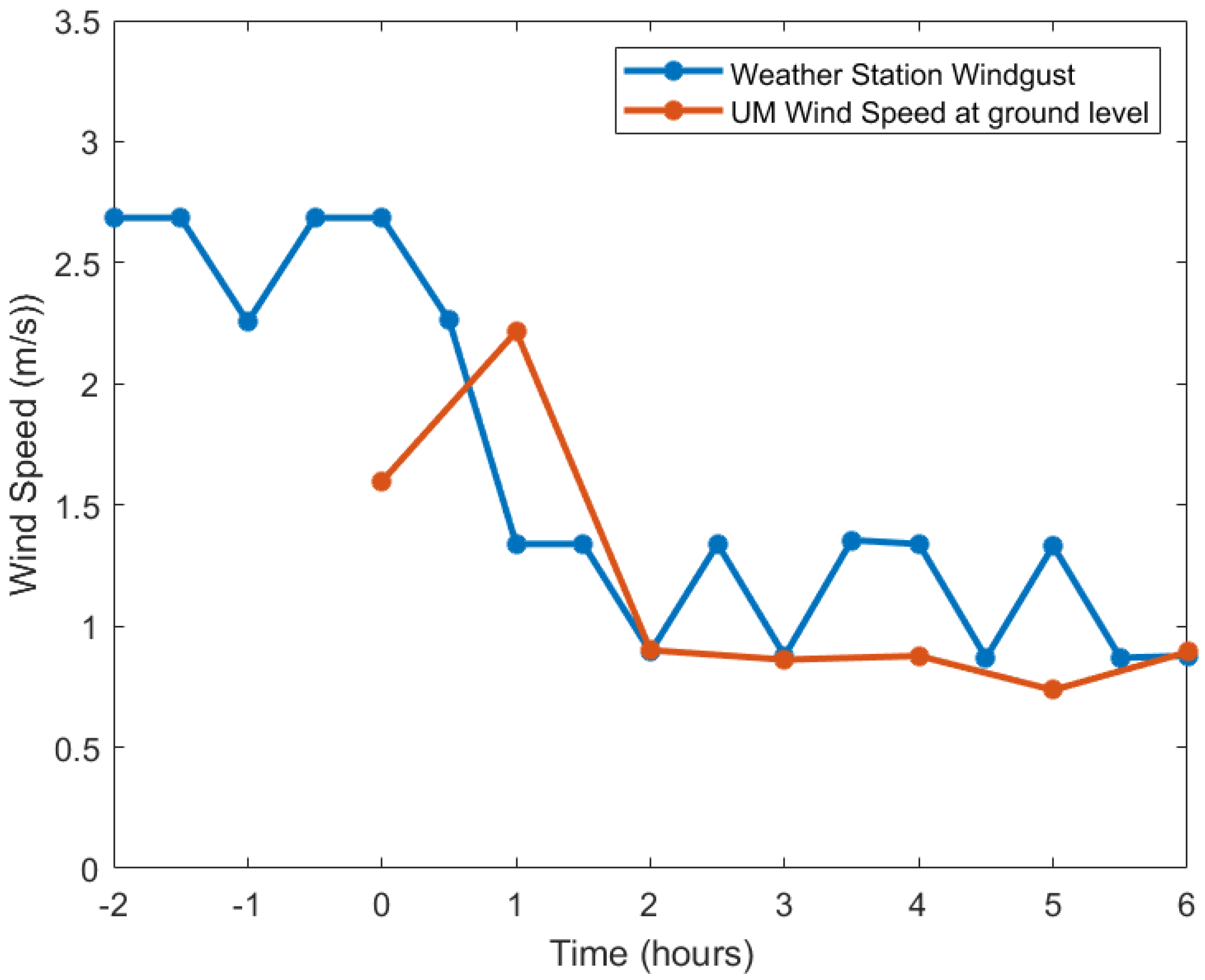

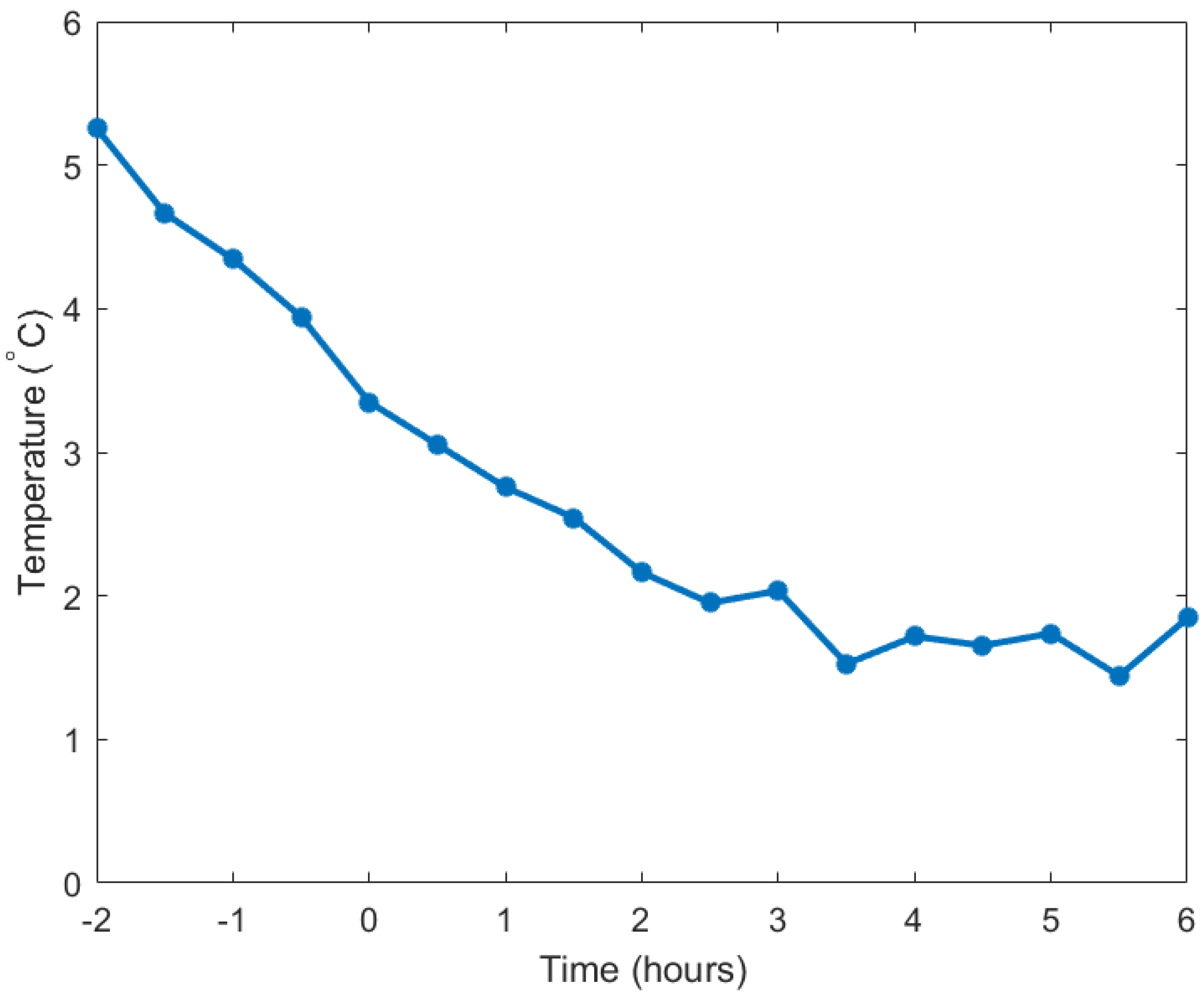
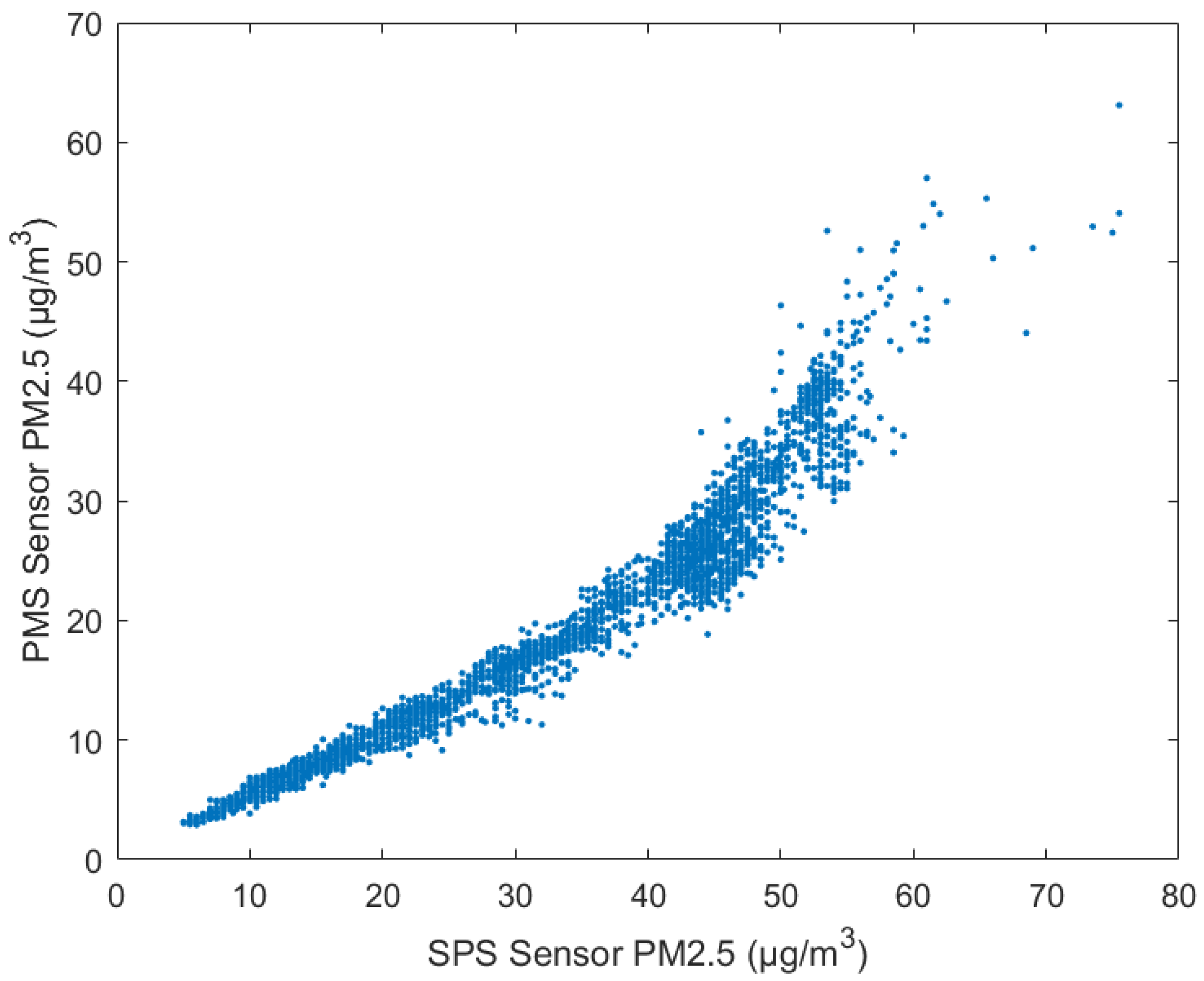
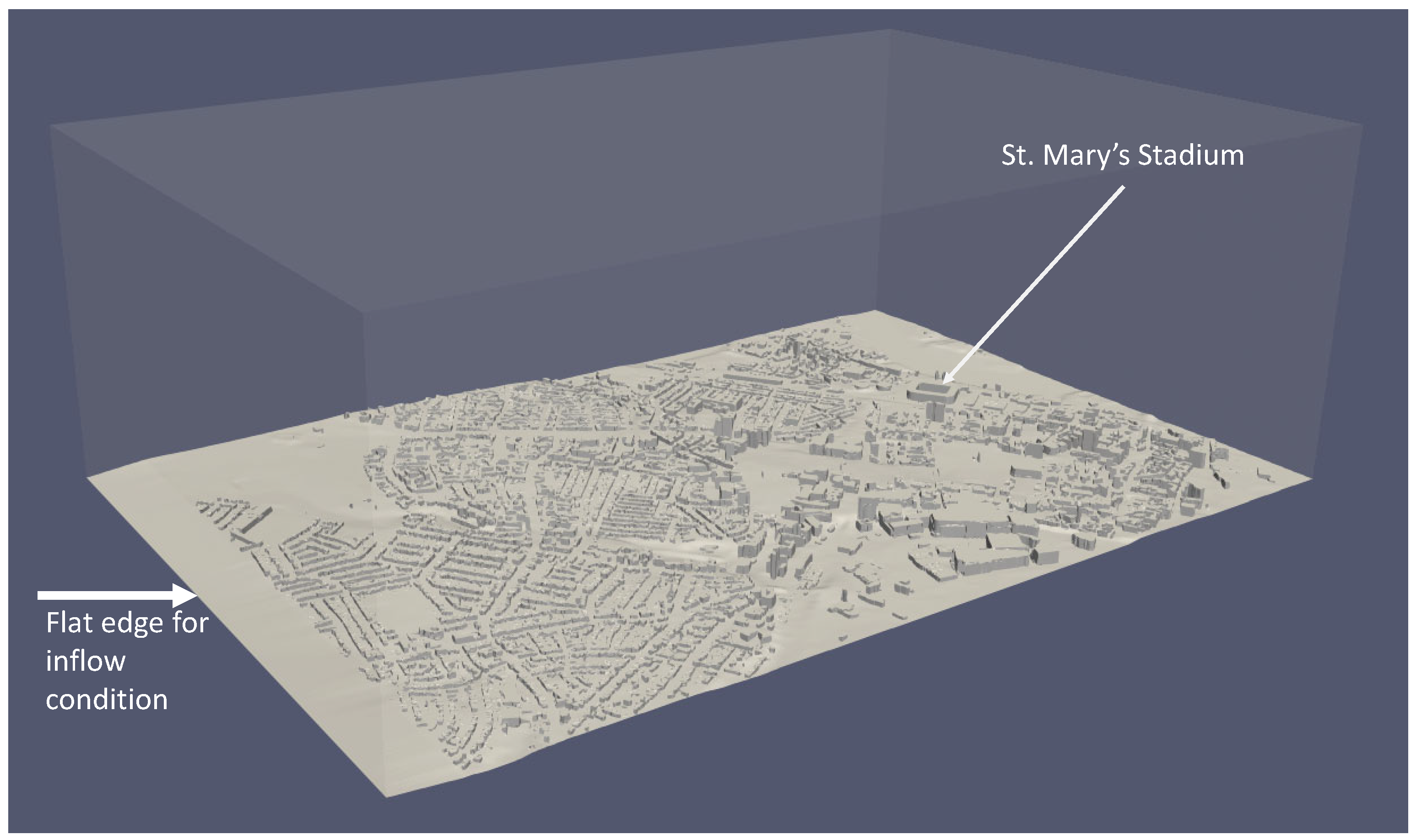

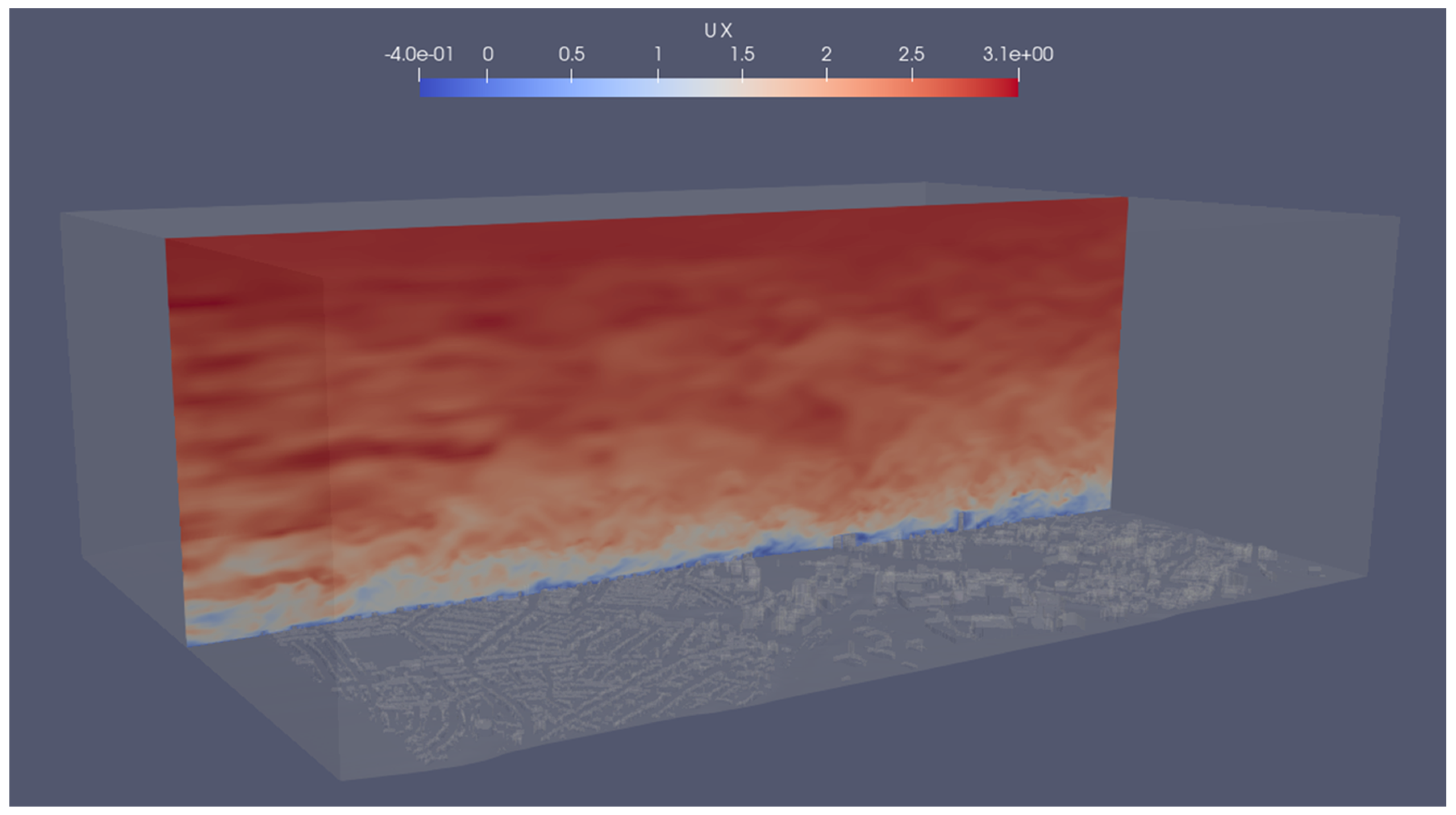
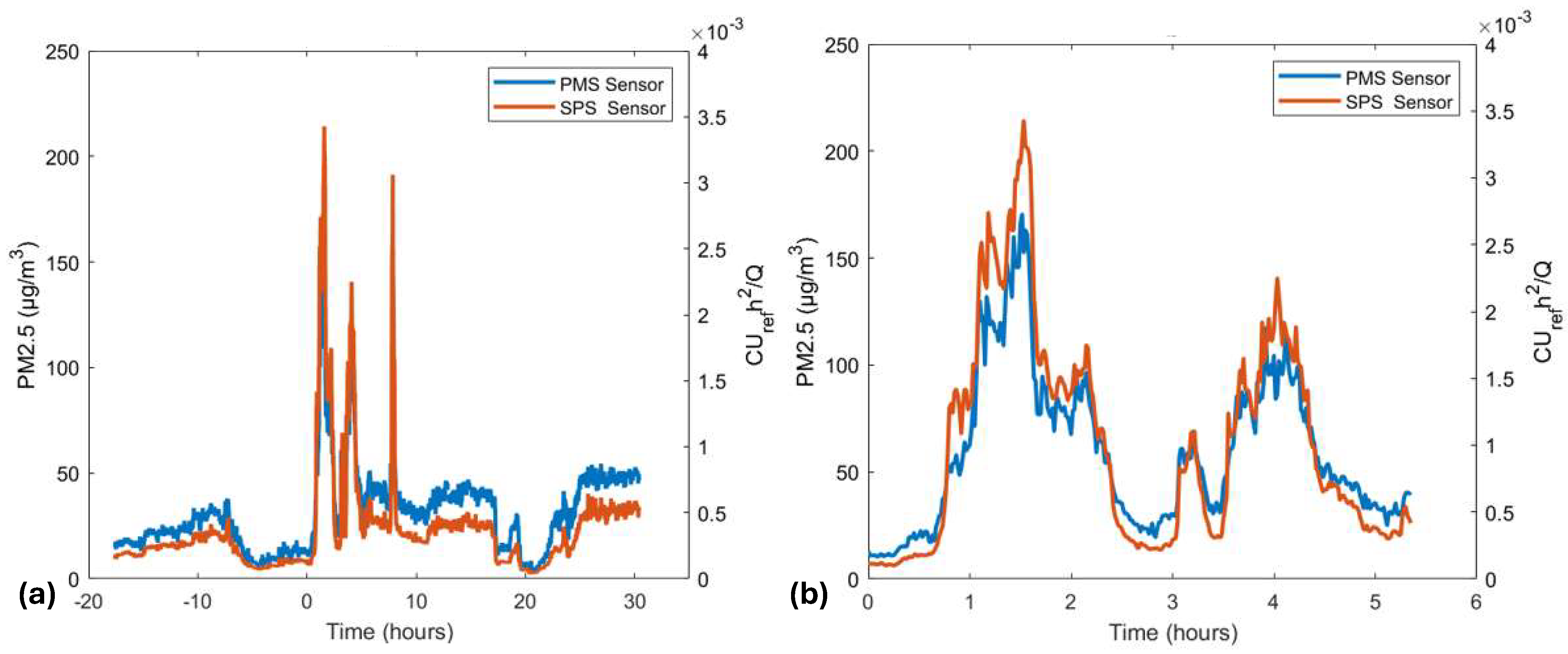



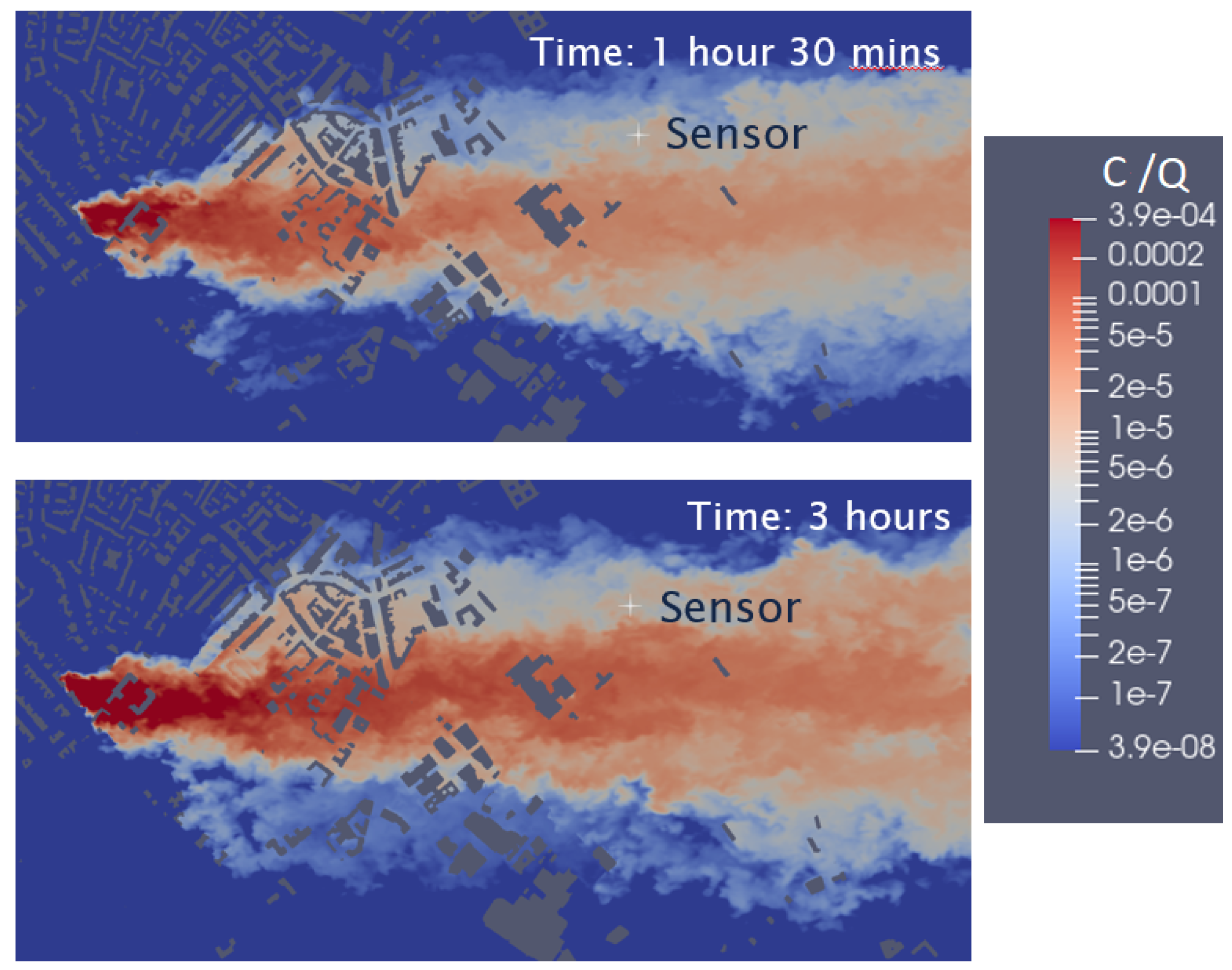
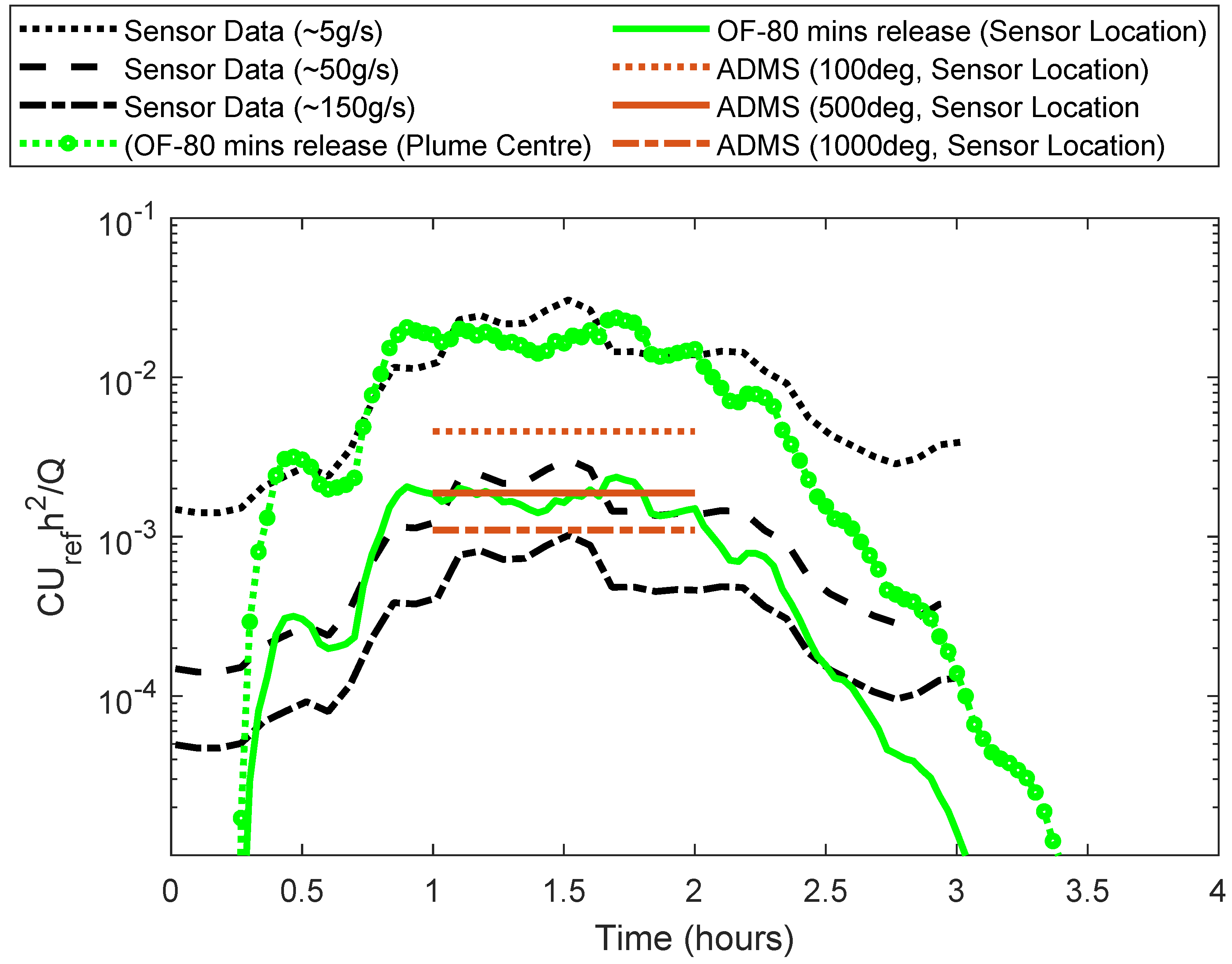

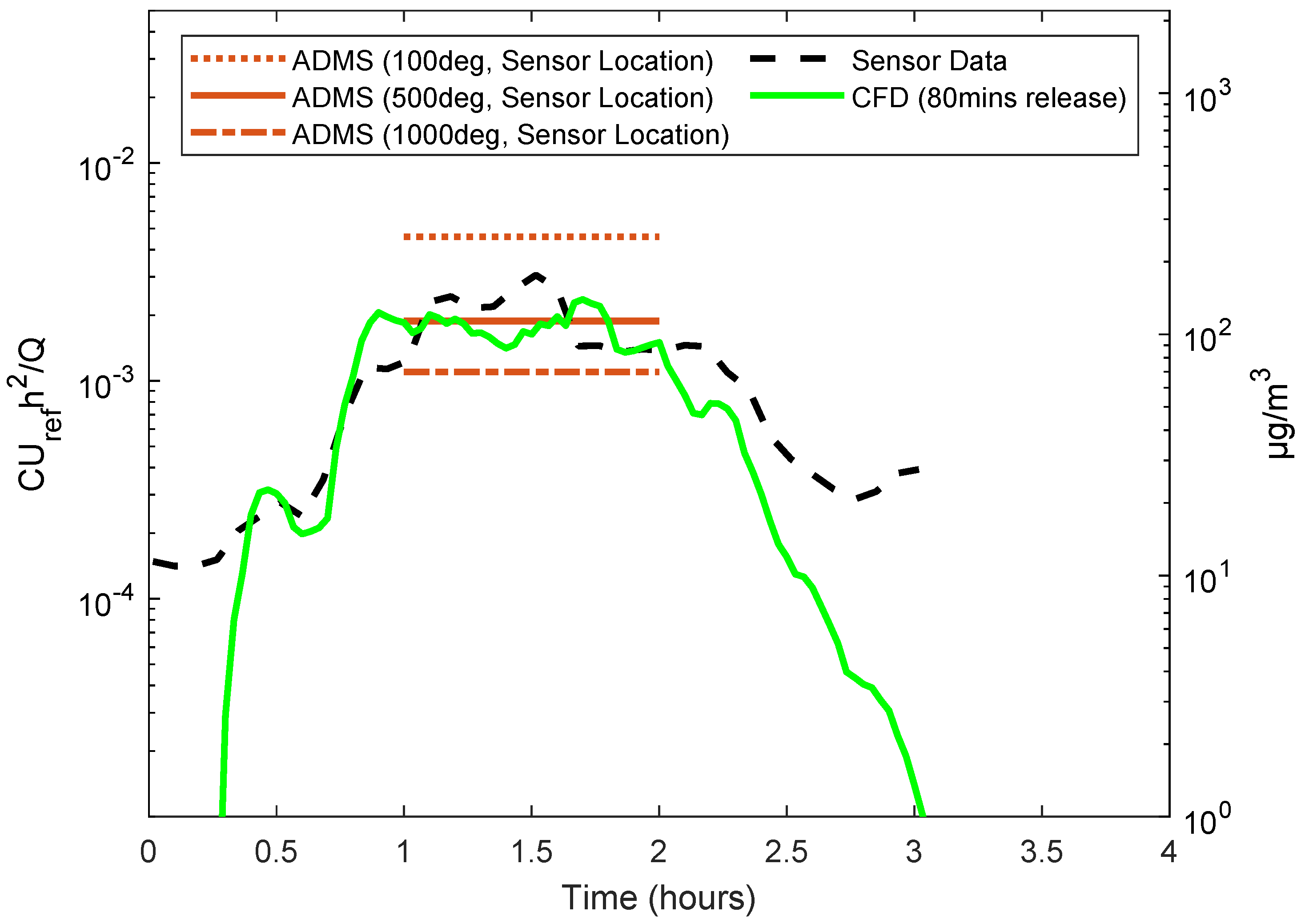
| LES | GPM | |
|---|---|---|
| Spatial resolution (m) | 1 | 10 |
| Temporal resolution (s) | 1 | 3600 |
| Complexity in setup | Complex | Simple |
| Wind speed and direction | Yes | Yes |
| Wind vertical profiles, etc. | Yes | No |
| Considering ABL stability | Yes but not here | Yes |
| Considering fire buoyancy | Yes but not here | Yes |
| User experience level | Experienced CFD user | Easy to use |
| Comput. cost (CPU hrs.) | O(104) | O(10−1) |
| Efficiency (wall-clock mins.) | 60 (Supercomputer) | 1 (Personal computer) |
| Output data dimensions | 3D in space & 1D in time | 2D in space |
| Output concentration | Mean & flucts., plume extent | Mean, plume extent |
| Potential apps. (now) | Support parameterization | Fast predict. for |
| for GPM improvement | scenarios as this case | |
| Potential apps. (future) | Fast predict. with supercomp. | Improved fast predict. |
Disclaimer/Publisher’s Note: The statements, opinions and data contained in all publications are solely those of the individual author(s) and contributor(s) and not of MDPI and/or the editor(s). MDPI and/or the editor(s) disclaim responsibility for any injury to people or property resulting from any ideas, methods, instructions or products referred to in the content. |
© 2024 by the authors. Licensee MDPI, Basel, Switzerland. This article is an open access article distributed under the terms and conditions of the Creative Commons Attribution (CC BY) license (https://creativecommons.org/licenses/by/4.0/).
Share and Cite
Clements, D.; Coburn, M.; Cox, S.J.; Bulot, F.M.J.; Xie, Z.-T.; Vanderwel, C. Comparing Large-Eddy Simulation and Gaussian Plume Model to Sensor Measurements of an Urban Smoke Plume. Atmosphere 2024, 15, 1089. https://doi.org/10.3390/atmos15091089
Clements D, Coburn M, Cox SJ, Bulot FMJ, Xie Z-T, Vanderwel C. Comparing Large-Eddy Simulation and Gaussian Plume Model to Sensor Measurements of an Urban Smoke Plume. Atmosphere. 2024; 15(9):1089. https://doi.org/10.3390/atmos15091089
Chicago/Turabian StyleClements, Dominic, Matthew Coburn, Simon J. Cox, Florentin M. J. Bulot, Zheng-Tong Xie, and Christina Vanderwel. 2024. "Comparing Large-Eddy Simulation and Gaussian Plume Model to Sensor Measurements of an Urban Smoke Plume" Atmosphere 15, no. 9: 1089. https://doi.org/10.3390/atmos15091089
APA StyleClements, D., Coburn, M., Cox, S. J., Bulot, F. M. J., Xie, Z.-T., & Vanderwel, C. (2024). Comparing Large-Eddy Simulation and Gaussian Plume Model to Sensor Measurements of an Urban Smoke Plume. Atmosphere, 15(9), 1089. https://doi.org/10.3390/atmos15091089







